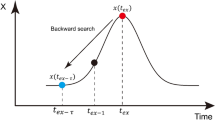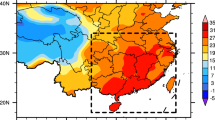Abstract
The attractor radius (AR) and global attractor radius (GAR) accurately characterize the intrinsic properties of chaotic systems and can be used to quantitatively estimate the practical and potential predictability of such systems. However, the AR and GAR fail to determine the local predictability of extreme events. In this study, the AR and GAR are first used to develop a new method of quantifying the local predictability of extreme events; i.e., backward searching for the initial condition (BaSIC). The BaSIC method is then used to quantitatively study the local predictability of the 2020/21 cold extremes that occurred in East Asia (EA). The EA regions have heterogeneous spatial distributions of practical predictability limits (PrPLs) of surface air temperature (SAT). The average PrPLs in December 2020 and January 2021 were 10 and 8 days, respectively, and the average potential predictability limits (PoPLs) of SAT exceeded 15 days for both months. Using the BaSIC method, the local PrPLs of three extreme cold events (ECEs) were quantitatively estimated to be 6, 8, and 6 days. By analyzing the dynamical growth of forecast errors, the forecast errors associated with these three ECEs were shown to have different spatial growth patterns. In addition, the northern regions of EA contributed significantly to the loss of local predictability for the three ECEs. Based on these results, the new method presented in this study (BaSIC) is a feasible and effective approach to investigating the local predictability of extreme events. It is expected to play a more important role in the fields of local predictability of extreme weather and climatic events in the future.












Similar content being viewed by others
Data availability
The TIGGE (The Interactive Grand Global Ensemble) (https://apps.ecmwf.int/datasets/data/tigge/levtype=sfc/type=pf/). The ERA5 and ERA-interim analysis is from https://cds.climate.copernicus.eu/cdsapp#!/dataset/reanalysis-era5-single-levels?tab=form and (https://apps.ecmwf.int/datasets/data/interim-full-daily/levtype=sfc/), respectively.
References
Barlow KM, Christy BP, O’leary G, Riffkin P, Nuttall J (2015) Simulating the impact of extreme heat and frost events on wheat crop production: a review. Field Crop Res 171:109–119
Bougeault P et al (2010) The THORPEX interactive grand global ensemble. B Am Meteorol Soc 91:1059–1072
Cattiaux J, Vautard R, Cassou C, Yiou P, Masson-Delmotte V, Codron F (2010) Winter 2010 in Europe: a cold extreme in a warming climate. Geophys Res Lett. https://doi.org/10.1029/2010GL044613
Cohen J et al (2020) Divergent consensuses on Arctic amplification influence on midlatitude severe winter weather. Nat Clim Change 10:20–29
Dai G, Mu M (2020) Arctic influence on the eastern Asian cold surge forecast: a case study of January 2016. J Geophys Res-Atmos. https://doi.org/10.1029/2020JD033298
Dee DP et al (2011) The ERA-Interim reanalysis: configuration and performance of the data assimilation system. Q J Roy Meteor Soc 137:553–597
Ding RQ, Li JP (2007) Nonlinear finite-time Lyapunov exponent and predictability. Phys Lett A 364:396–400
Ding Y, Sikka D (2006) Synoptic systems and weather. The asian monsoon. Praxis, UK, pp 131–201
Duan WS, Mu M (2009) Conditional nonlinear optimal perturbation: applications to stability, sensitivity, and predictability. Sci China Ser D 52:883–906
Feng GL, He W (2007) Amplitude death in steadily forced chaotic systems. Chin Phys 16(9):2825
Feng J, Li J, Zhang J, Liu D, Ding R (2019) The relationship between deterministic and ensemble mean forecast errors revealed by global and local attractor radii. Adv Atmos Sci 36:271–278
Fraedrich K (1986) Estimating the dimensions of weather and climate attractors. J Atmos Sci 43:419–432
Gao Y, Leung LR, Lu J, Masato G (2015) Persistent cold air outbreaks over North America in a warming climate. Environ Res Lett 10:044001
He W, Feng GL, Dong W, Li J (2006) On the predictability of the Lorenz system. Acta Physica Sinica 55(2):969–977
He W, Wang L, Jiang Y et al (2016) 2016: An improved method for nonlinear parameter estimation: a case study of the Rössler model. Theor Appl Climatol 125(3):521–528
He W, Xie X, Mei Y, Wan S, Zhao S (2021) Decreasing predictability as a precursor indicator for abrupt climate change. Clim Dynam 56:3899–3908
Hersbach H et al (2020) The ERA5 global reanalysis. Q J R Meteorol Soc 146:1999–2049
Hochman A, Scher S, Quinting J, Pinto JG, Messori G (2020) Dynamics and predictability of cold spells over the Eastern Mediterranean. Clim. Dynam. 58:2047–2064
Johnson NC, Xie S-P, Kosaka Y, Li X (2018) Increasing occurrence of cold and warm extremes during the recent global warming slowdown. Nat Commun 9:1–12
Kautz LA, Polichtchouk I, Birner T, Garny H, Pinto JG (2020) Enhanced extended-range predictability of the 2018 late-winter Eurasian cold spell due to the stratosphere. Q J R Meteorol Soc 146:1040–1055
Kodra E, Steinhaeuser K, Ganguly AR (2011) Persisting cold extremes under 21st-century warming scenarios. Geophys Res Lett. https://doi.org/10.1029/2011GL047103
Li JP, Feng J, Ding RQ (2017) Attractor radius and global attractor radius and their application to the quantification of predictability limits. Clim Dynam 51:2359–2374
Li X, Ding R, Li J (2019) Determination of the backward predictability limit and its relationship with the forward predictability limit. Adv Atmos Sci 36:669–677
Li X, Ding R, Li J (2020) Quantitative study of the relative effects of initial condition and model uncertainties on local predictability in a nonlinear dynamical system. Chaos Soliton Fract 139:110094
Li J et al (2021) Influence of the NAO on wintertime surface air temperature over East Asia: multidecadal variability and decadal prediction. Adv Atmos Sci 39:625–642
Li X, Ding R, Li J (2022) A new technique to quantify the local predictability of extreme events: the backward nonlinear local Lyapunov exponent method. Front Env Sci-Switz. https://doi.org/10.3389/fenvs.2022.825233
Lorenz EN (1963) Deterministic nonperiodic flow. J Atmos Sci 20:130–141
Lorenz EN (1969) Three approaches to atmospheric predictability. Bull Am Meteorol Soc 50(3454):349
Ma Y, Li J, Zhang S, Zhao H (2021) A multi-model study of atmosphere predictability in coupled ocean–atmosphere systems. Clim Dynam 56:3489–3509
Mohamad MA, Sapsis TP (2018) Sequential sampling strategy for extreme event statistics in nonlinear dynamical systems. P Natl Acad Sci USA 115:11138–11143
Mu M, Duan W, Wang B (2003) Conditional nonlinear optimal perturbation and its applications. Nonlinear Proc Geoph 10:493–501
Nese JM (1989) Quantifying local predictability in phase space. Physica D 35:237–250
Swinbank R et al (2016) The TIGGE project and its achievements. B Am Meteorol Soc 97:49–67
Vihma T et al (2020) Effects of the tropospheric large-scale circulation on European winter temperatures during the period of amplified Arctic warming. Int J Climatol 40:509–529
Vitart F et al (2017) The subseasonal to seasonal (S2S) prediction project database. Bull Am Meteorol Soc 98:163–173
Wolf A, Swift JB, Swinney HL, Vastano JA (1985) Determining Lyapunov exponents from a time series. Physica D 16:285–317
Wu B, Su J, Zhang R (2011) Effects of autumn-winter Arctic sea ice on winter Siberian high. Chinese Sci Bull 56:3220–3228
Xiang B, Sun YQ, Chen JH, Johnson NC, Jiang X (2020) Subseasonal prediction of land cold extremes in boreal wintertime. J Geophys Res-Atmos. https://doi.org/10.1029/2020JD032670
Yamaguchi J, Kanno Y, Chen G, Iwasaki T (2019) Cold air mass analysis of the record-breaking cold surge event over East Asia in January 2016. J Meteorol Soc Jpn. https://doi.org/10.2151/jmsj.2019-015
Yoden S, Nomura M (1993) Finite-time Lyapunov stability analysis and its application to atmospheric predictability. J Atmos Sci 50:1531–1543
Yu L, Wu Z, Zhang R, Yang X (2018) Partial least regression approach to forecast the East Asian winter monsoon using Eurasian snow cover and sea surface temperature. Clim Dynam 51:4573–4584
Zhang X et al (2022) Extreme cold events from East Asia to North America in winter 2020/21: comparisons, causes, and future implications. Adv Atmos Sci 39:553–565
Zhao H, Zhang S, Li J, Ma Y (2021) A study of predictability of coupled ocean–atmosphere system using attractor radius and global attractor radius. Clim Dynam 56:1317–1334
Zheng F et al (2021) The 2020/21 extremely cold winter in China influenced by the synergistic effect of La Niña and warm Arctic. Adv Atmos Sci 39:545–552
Zhou W, Chan JC, Chen W, Ling J, Pinto JG, Shao Y (2009) Synoptic-scale controls of persistent low temperature and icy weather over southern China in January 2008. Mon Wea Rev 137:3978–3991
Zhou T et al (2022) 2021: a year of unprecedented climate extremes in Eastern Asia, North America, and Europe. Adv Atmos Sci 39:1598–1607
Acknowledgements
We would like to thank Dr. Jie Feng for the discussion. This work was jointly supported by the National Natural Science Foundation of China (Grant Nos. 42005054 and 41975070) and China Postdoctoral Science Foundation (2020M681154).
Funding
This work was jointly supported by the National Natural Science Foundation of China (Grant Nos. 42005054 and 41975070) and China Postdoctoral Science Foundation (2020M681154).
Author information
Authors and Affiliations
Contributions
The first draft of the manuscript was written by XL. RD and JL commented on initial versions of the manuscript. All authors read and approved the final manuscript.
Corresponding author
Ethics declarations
Conflict of interest
The authors have no relevant financial or non-financial interests to disclose.
Additional information
Publisher's Note
Springer Nature remains neutral with regard to jurisdictional claims in published maps and institutional affiliations.
Rights and permissions
Springer Nature or its licensor holds exclusive rights to this article under a publishing agreement with the author(s) or other rightsholder(s); author self-archiving of the accepted manuscript version of this article is solely governed by the terms of such publishing agreement and applicable law.
About this article
Cite this article
Li, X., Ding, R. & Li, J. The BaSIC method: a new approach to quantitatively assessing the local predictability of extreme weather events. Clim Dyn 60, 3561–3576 (2023). https://doi.org/10.1007/s00382-022-06526-4
Received:
Accepted:
Published:
Issue Date:
DOI: https://doi.org/10.1007/s00382-022-06526-4




